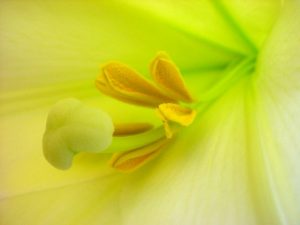Easter lilies are the perfect symbol to mark the beginning of the spring season. The large, white, trumpet-shaped flowers bring a bit of spring fragrance into the home but can also be enjoyed outdoors later in the season.
Like other lilies, the Easter lily grows from a bulb in the soil. This bulb stores food reserves that are used by the plant to produce foliage and flower growth. If encouraged to build up food reserves, the bulb will be able to make a second show later in summer.
Most gardeners tend to kill their plants with kindness – in other words, overwatering. Water when the top inch or so of soil becomes dry to the touch. Apply enough water so that some drains from the bottom of the pot. The Easter lily often comes with the pot wrapped in decorative foil. Either remove the foil or poke holes through the bottom to allow excess water to escape. Discard the drained water.
Easter lilies last longer in moderately cool temperatures. Keep flowers out of direct sunlight and away from drafts such as an entry door or heating vents.
The bright yellow pollen-bearing anthers provide lovely contrast to the white petals of the trumpet. But removing the anthers before they release their pollen will prevent staining of the petals and prolong flower life. You can easily remove the anthers with tweezers or your fingertips as soon as the flower opens.
Wait to fertilize until after the bloom has faded to help rebuild the bulb’s food reserves. Use a fertilizer labeled for flowering plants, according to package instructions, or a general-purpose balanced fertilizer, such as 12-12-12, at the rate of one-half teaspoon per gallon of water. Move the plant to a sunny window.
After danger of frost is past for your area, plant the bulb outdoors in a sunny, well-drained location so that the top of the bulb is 6 inches below the soil surface. Allow the stalk to grow for several weeks until it begins to turn brown. The bulb is now “resting,” and the withered stalk should be removed. Soon, a new stalk will appear, and by late summer a second season of bloom should occur.
Easter lilies are generally not winter hardy in most parts of the Midwest. Applying winter mulch may give enough protection to see the plants through a mild winter. After the tops have died back in autumn, apply 2-3 inches of straw, chopped leaves or shredded bark. Be sure to remove the mulch in spring as new growth appears. If the plant does survive, blooms will appear in summer.

